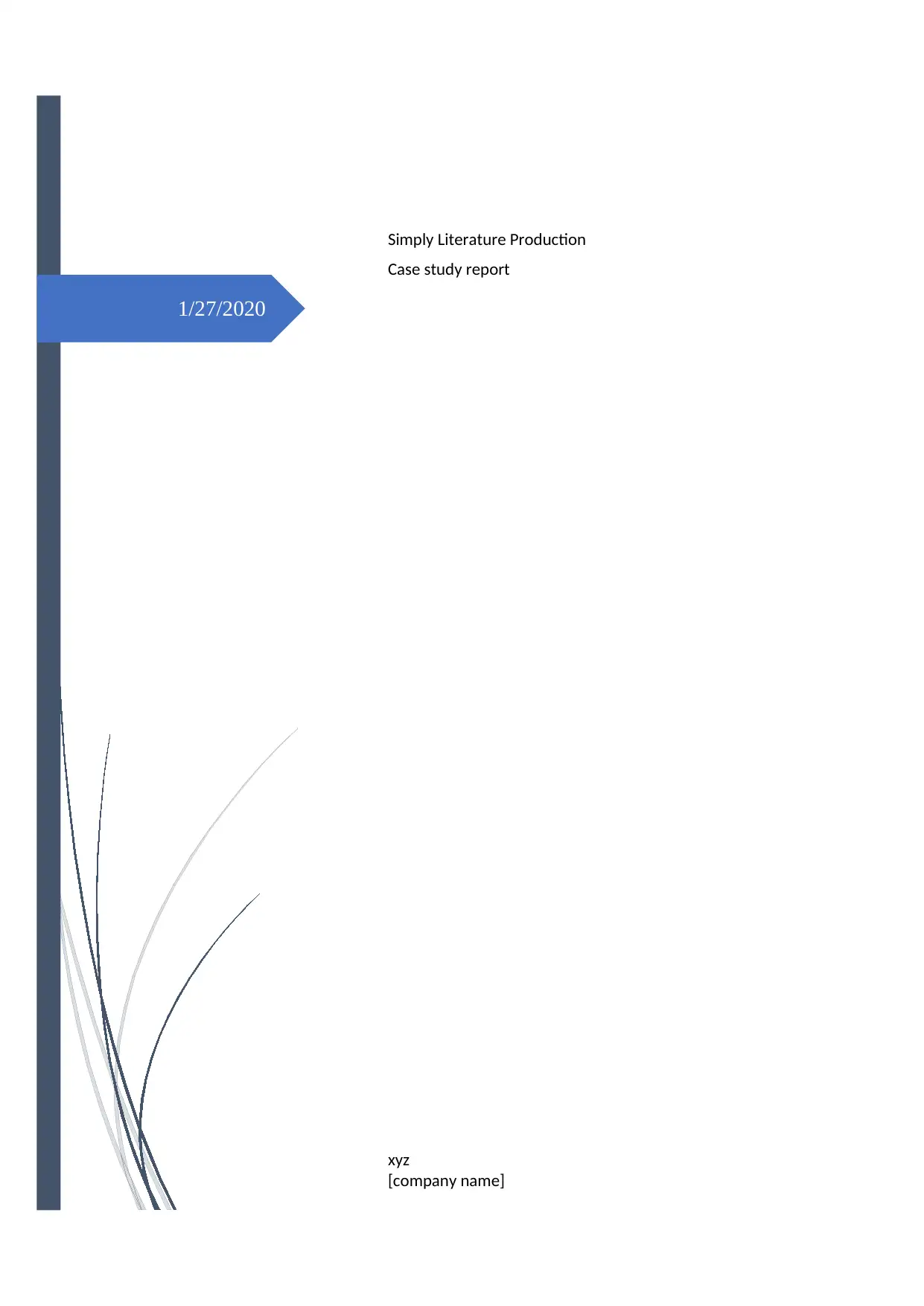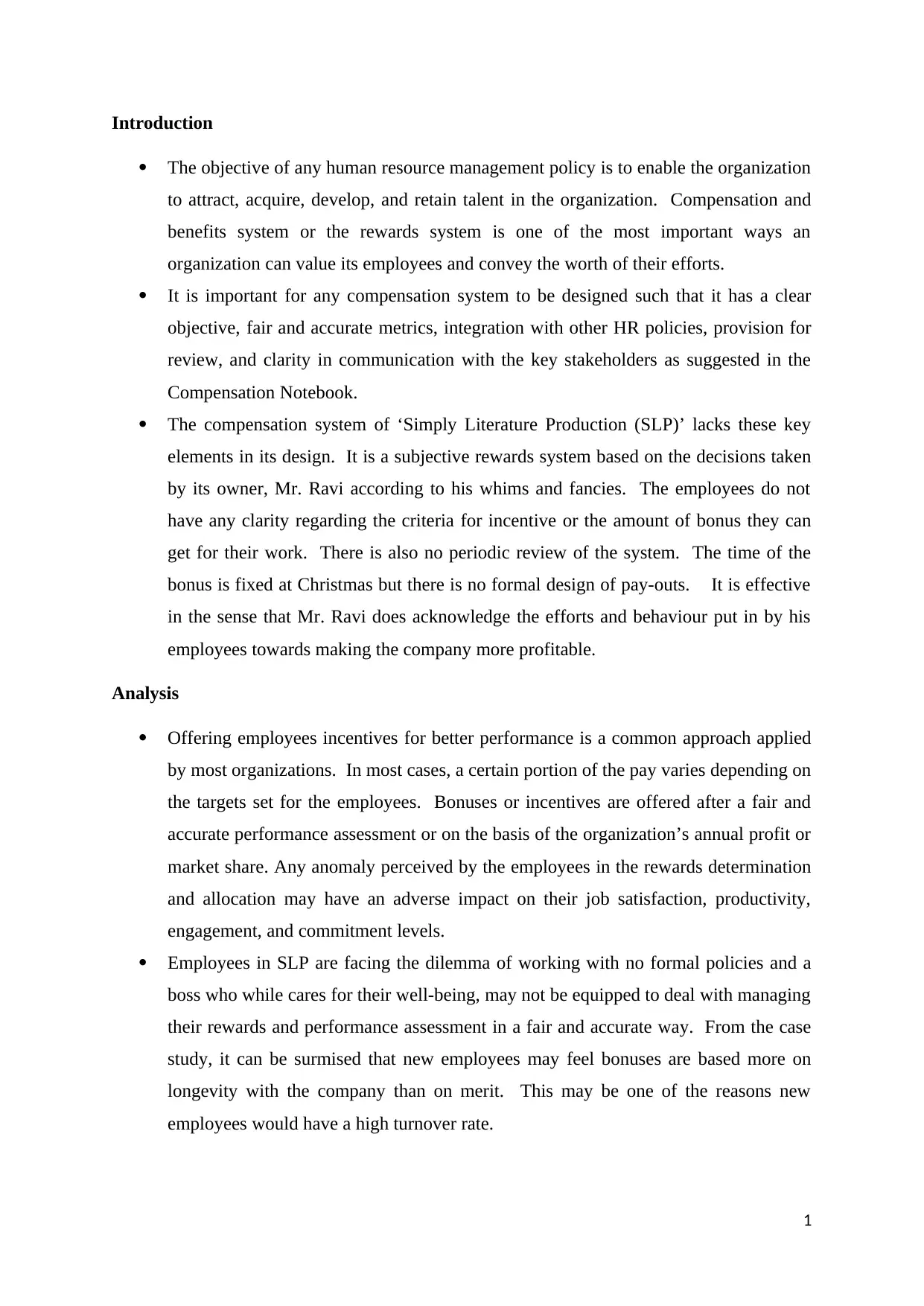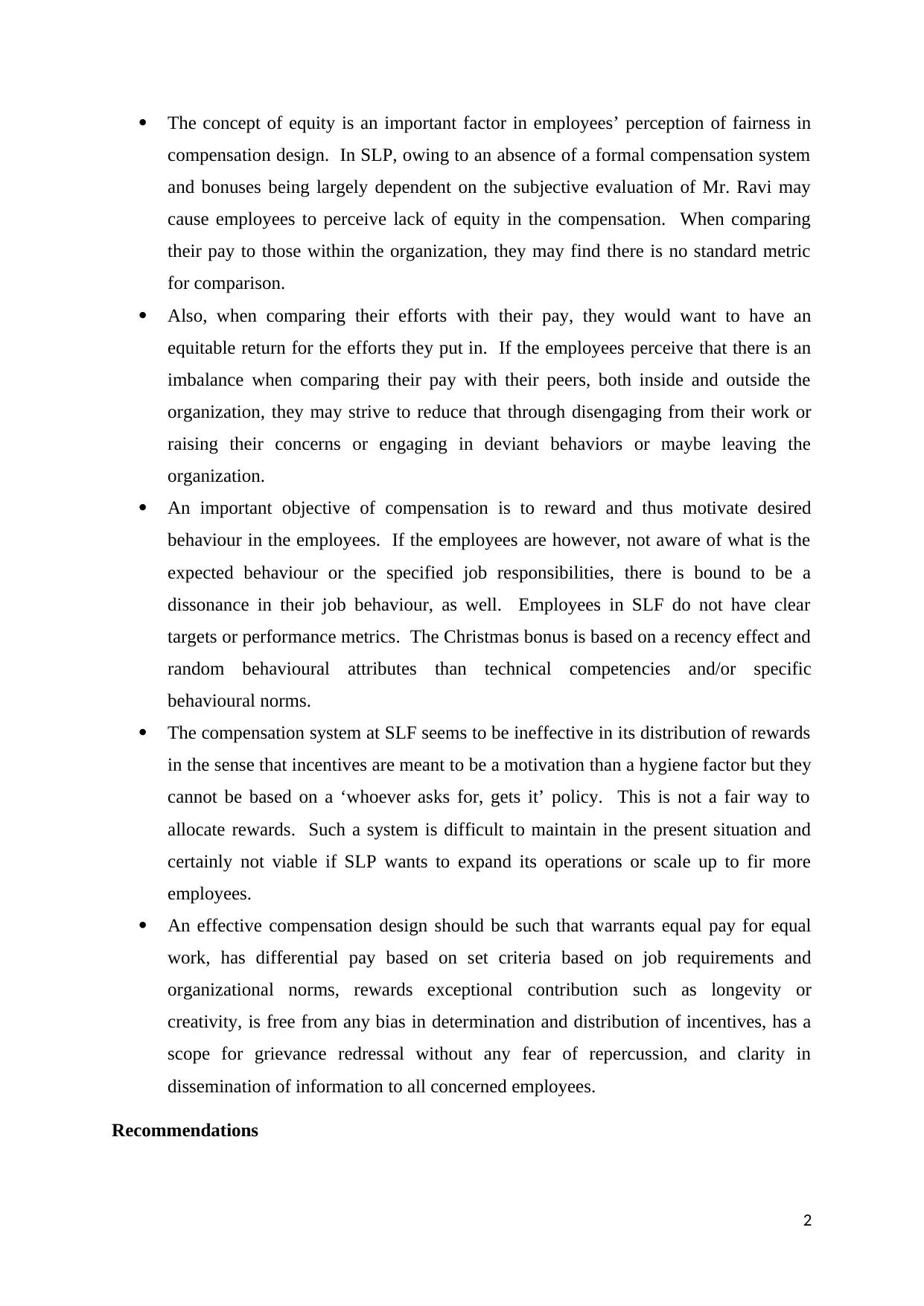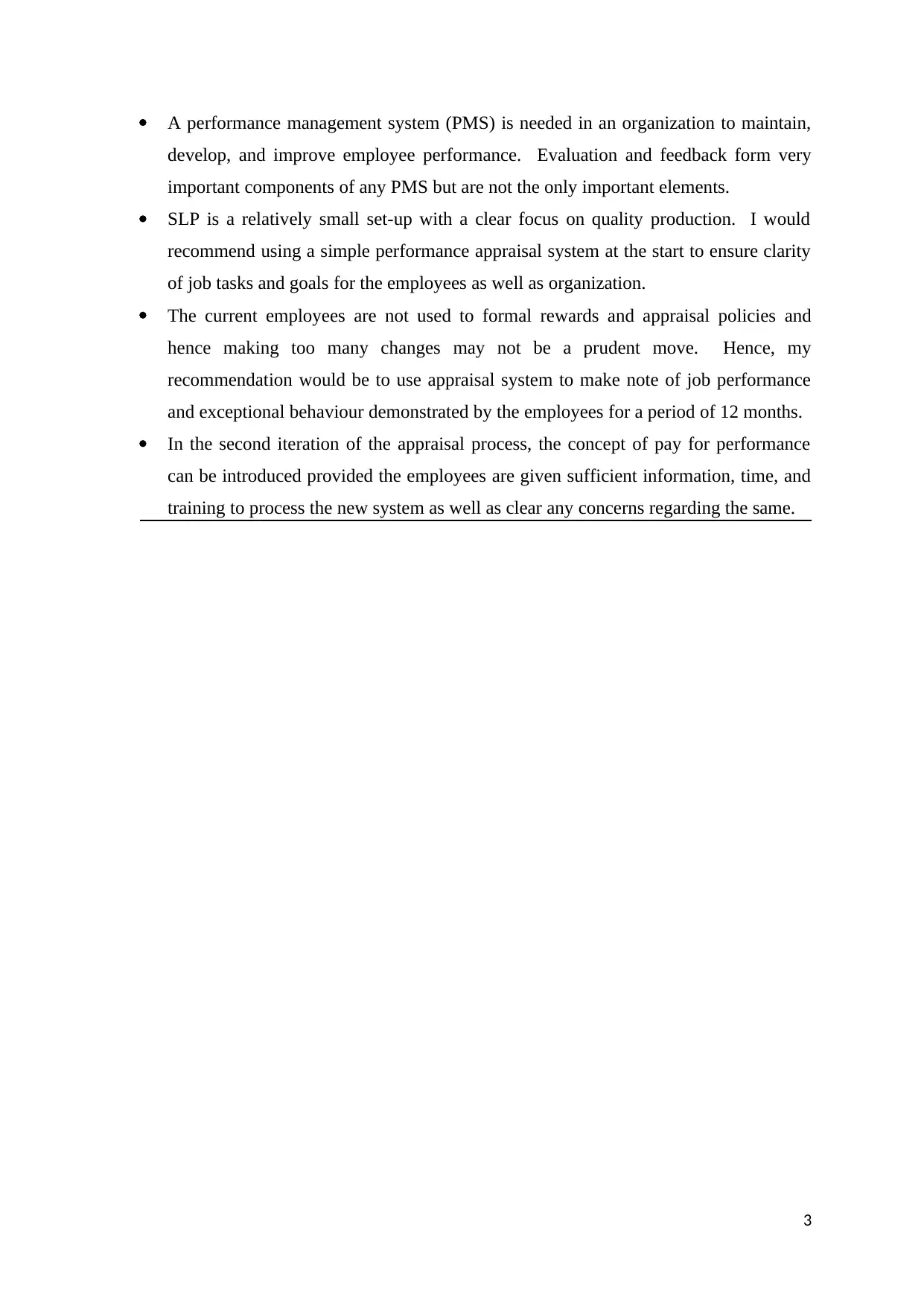Case Study Report: Analysis of Simply Literature Production's System
VerifiedAdded on 2022/08/19
|5
|1011
|14
Case Study
AI Summary
This case study analyzes the compensation and rewards system of Simply Literature Production (SLP), highlighting its shortcomings in attracting, acquiring, developing, and retaining talent. The current system, based on the owner's subjective decisions, lacks clear objectives, fair metrics, and regular reviews, leading to employee uncertainty and potential inequity. The report examines the impact of this system on employee job satisfaction, engagement, and turnover, emphasizing the need for a formal performance management system (PMS). Recommendations include implementing a simple appraisal system to clarify job tasks and goals, followed by introducing pay-for-performance based on clear criteria, sufficient information, and training. The study underscores the importance of equal pay, differential pay based on job requirements, and transparent communication to create a fair and motivating work environment, especially for SLP's future growth and expansion.

1/27/2020
Simply Literature Production
Case study report
xyz
[company name]
Simply Literature Production
Case study report
xyz
[company name]
Paraphrase This Document
Need a fresh take? Get an instant paraphrase of this document with our AI Paraphraser

Introduction
The objective of any human resource management policy is to enable the organization
to attract, acquire, develop, and retain talent in the organization. Compensation and
benefits system or the rewards system is one of the most important ways an
organization can value its employees and convey the worth of their efforts.
It is important for any compensation system to be designed such that it has a clear
objective, fair and accurate metrics, integration with other HR policies, provision for
review, and clarity in communication with the key stakeholders as suggested in the
Compensation Notebook.
The compensation system of ‘Simply Literature Production (SLP)’ lacks these key
elements in its design. It is a subjective rewards system based on the decisions taken
by its owner, Mr. Ravi according to his whims and fancies. The employees do not
have any clarity regarding the criteria for incentive or the amount of bonus they can
get for their work. There is also no periodic review of the system. The time of the
bonus is fixed at Christmas but there is no formal design of pay-outs. It is effective
in the sense that Mr. Ravi does acknowledge the efforts and behaviour put in by his
employees towards making the company more profitable.
Analysis
Offering employees incentives for better performance is a common approach applied
by most organizations. In most cases, a certain portion of the pay varies depending on
the targets set for the employees. Bonuses or incentives are offered after a fair and
accurate performance assessment or on the basis of the organization’s annual profit or
market share. Any anomaly perceived by the employees in the rewards determination
and allocation may have an adverse impact on their job satisfaction, productivity,
engagement, and commitment levels.
Employees in SLP are facing the dilemma of working with no formal policies and a
boss who while cares for their well-being, may not be equipped to deal with managing
their rewards and performance assessment in a fair and accurate way. From the case
study, it can be surmised that new employees may feel bonuses are based more on
longevity with the company than on merit. This may be one of the reasons new
employees would have a high turnover rate.
1
The objective of any human resource management policy is to enable the organization
to attract, acquire, develop, and retain talent in the organization. Compensation and
benefits system or the rewards system is one of the most important ways an
organization can value its employees and convey the worth of their efforts.
It is important for any compensation system to be designed such that it has a clear
objective, fair and accurate metrics, integration with other HR policies, provision for
review, and clarity in communication with the key stakeholders as suggested in the
Compensation Notebook.
The compensation system of ‘Simply Literature Production (SLP)’ lacks these key
elements in its design. It is a subjective rewards system based on the decisions taken
by its owner, Mr. Ravi according to his whims and fancies. The employees do not
have any clarity regarding the criteria for incentive or the amount of bonus they can
get for their work. There is also no periodic review of the system. The time of the
bonus is fixed at Christmas but there is no formal design of pay-outs. It is effective
in the sense that Mr. Ravi does acknowledge the efforts and behaviour put in by his
employees towards making the company more profitable.
Analysis
Offering employees incentives for better performance is a common approach applied
by most organizations. In most cases, a certain portion of the pay varies depending on
the targets set for the employees. Bonuses or incentives are offered after a fair and
accurate performance assessment or on the basis of the organization’s annual profit or
market share. Any anomaly perceived by the employees in the rewards determination
and allocation may have an adverse impact on their job satisfaction, productivity,
engagement, and commitment levels.
Employees in SLP are facing the dilemma of working with no formal policies and a
boss who while cares for their well-being, may not be equipped to deal with managing
their rewards and performance assessment in a fair and accurate way. From the case
study, it can be surmised that new employees may feel bonuses are based more on
longevity with the company than on merit. This may be one of the reasons new
employees would have a high turnover rate.
1

The concept of equity is an important factor in employees’ perception of fairness in
compensation design. In SLP, owing to an absence of a formal compensation system
and bonuses being largely dependent on the subjective evaluation of Mr. Ravi may
cause employees to perceive lack of equity in the compensation. When comparing
their pay to those within the organization, they may find there is no standard metric
for comparison.
Also, when comparing their efforts with their pay, they would want to have an
equitable return for the efforts they put in. If the employees perceive that there is an
imbalance when comparing their pay with their peers, both inside and outside the
organization, they may strive to reduce that through disengaging from their work or
raising their concerns or engaging in deviant behaviors or maybe leaving the
organization.
An important objective of compensation is to reward and thus motivate desired
behaviour in the employees. If the employees are however, not aware of what is the
expected behaviour or the specified job responsibilities, there is bound to be a
dissonance in their job behaviour, as well. Employees in SLF do not have clear
targets or performance metrics. The Christmas bonus is based on a recency effect and
random behavioural attributes than technical competencies and/or specific
behavioural norms.
The compensation system at SLF seems to be ineffective in its distribution of rewards
in the sense that incentives are meant to be a motivation than a hygiene factor but they
cannot be based on a ‘whoever asks for, gets it’ policy. This is not a fair way to
allocate rewards. Such a system is difficult to maintain in the present situation and
certainly not viable if SLP wants to expand its operations or scale up to fir more
employees.
An effective compensation design should be such that warrants equal pay for equal
work, has differential pay based on set criteria based on job requirements and
organizational norms, rewards exceptional contribution such as longevity or
creativity, is free from any bias in determination and distribution of incentives, has a
scope for grievance redressal without any fear of repercussion, and clarity in
dissemination of information to all concerned employees.
Recommendations
2
compensation design. In SLP, owing to an absence of a formal compensation system
and bonuses being largely dependent on the subjective evaluation of Mr. Ravi may
cause employees to perceive lack of equity in the compensation. When comparing
their pay to those within the organization, they may find there is no standard metric
for comparison.
Also, when comparing their efforts with their pay, they would want to have an
equitable return for the efforts they put in. If the employees perceive that there is an
imbalance when comparing their pay with their peers, both inside and outside the
organization, they may strive to reduce that through disengaging from their work or
raising their concerns or engaging in deviant behaviors or maybe leaving the
organization.
An important objective of compensation is to reward and thus motivate desired
behaviour in the employees. If the employees are however, not aware of what is the
expected behaviour or the specified job responsibilities, there is bound to be a
dissonance in their job behaviour, as well. Employees in SLF do not have clear
targets or performance metrics. The Christmas bonus is based on a recency effect and
random behavioural attributes than technical competencies and/or specific
behavioural norms.
The compensation system at SLF seems to be ineffective in its distribution of rewards
in the sense that incentives are meant to be a motivation than a hygiene factor but they
cannot be based on a ‘whoever asks for, gets it’ policy. This is not a fair way to
allocate rewards. Such a system is difficult to maintain in the present situation and
certainly not viable if SLP wants to expand its operations or scale up to fir more
employees.
An effective compensation design should be such that warrants equal pay for equal
work, has differential pay based on set criteria based on job requirements and
organizational norms, rewards exceptional contribution such as longevity or
creativity, is free from any bias in determination and distribution of incentives, has a
scope for grievance redressal without any fear of repercussion, and clarity in
dissemination of information to all concerned employees.
Recommendations
2
⊘ This is a preview!⊘
Do you want full access?
Subscribe today to unlock all pages.

Trusted by 1+ million students worldwide

A performance management system (PMS) is needed in an organization to maintain,
develop, and improve employee performance. Evaluation and feedback form very
important components of any PMS but are not the only important elements.
SLP is a relatively small set-up with a clear focus on quality production. I would
recommend using a simple performance appraisal system at the start to ensure clarity
of job tasks and goals for the employees as well as organization.
The current employees are not used to formal rewards and appraisal policies and
hence making too many changes may not be a prudent move. Hence, my
recommendation would be to use appraisal system to make note of job performance
and exceptional behaviour demonstrated by the employees for a period of 12 months.
In the second iteration of the appraisal process, the concept of pay for performance
can be introduced provided the employees are given sufficient information, time, and
training to process the new system as well as clear any concerns regarding the same.
3
develop, and improve employee performance. Evaluation and feedback form very
important components of any PMS but are not the only important elements.
SLP is a relatively small set-up with a clear focus on quality production. I would
recommend using a simple performance appraisal system at the start to ensure clarity
of job tasks and goals for the employees as well as organization.
The current employees are not used to formal rewards and appraisal policies and
hence making too many changes may not be a prudent move. Hence, my
recommendation would be to use appraisal system to make note of job performance
and exceptional behaviour demonstrated by the employees for a period of 12 months.
In the second iteration of the appraisal process, the concept of pay for performance
can be introduced provided the employees are given sufficient information, time, and
training to process the new system as well as clear any concerns regarding the same.
3
Paraphrase This Document
Need a fresh take? Get an instant paraphrase of this document with our AI Paraphraser

4
1 out of 5
Your All-in-One AI-Powered Toolkit for Academic Success.
+13062052269
info@desklib.com
Available 24*7 on WhatsApp / Email
![[object Object]](/_next/static/media/star-bottom.7253800d.svg)
Unlock your academic potential
Copyright © 2020–2025 A2Z Services. All Rights Reserved. Developed and managed by ZUCOL.


